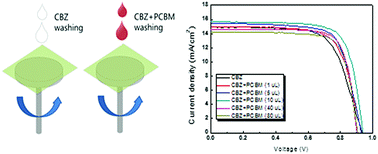PCBM-blended chlorobenzene hybrid anti-solvent engineering for efficient planar perovskite solar cells†
Abstract
We suggest a phenyl-C61-butyric acid methyl ester (PCBM)-blended chlorobenzene (CBZ) hybrid anti-solvent washing technique for the morphological control of perovskite films. Compared to standard CBZ washing, the CBZ + PCBM hybrid washing technique endows perovskite films with a pinhole-free and compact surface morphology. Surface topography combined with phase imaging using atomic force microscopy showed that PCBM could fill up the voids and pinholes on the perovskite surfaces. Inverted planar perovskite solar cells processed using this new approach exhibited an impressive increase in the average fill factor from 0.583 to 0.747 for 40 tested devices by reducing charge recombination through the pinholes, which also contributed to an enhancement of the power conversion efficiency of the best performing cells of about 16.1% (from 9.48 to 11.01%). Furthermore, the fabricated devices showed negligible hysteresis phenomena. The presented results suggest a new and simple approach that reinforces the feasibility of low-temperature-processed inverted planar perovskite photovoltaics with enhanced performances.



 Please wait while we load your content...
Please wait while we load your content...